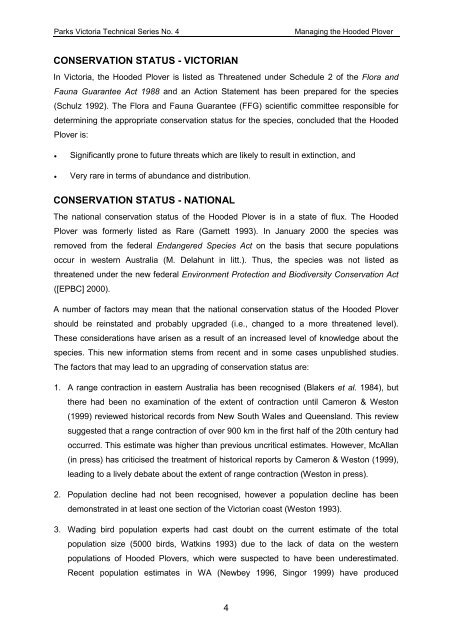Managing the Hooded Plover - Parks Victoria
Managing the Hooded Plover - Parks Victoria
Managing the Hooded Plover - Parks Victoria
Create successful ePaper yourself
Turn your PDF publications into a flip-book with our unique Google optimized e-Paper software.
<strong>Parks</strong> <strong>Victoria</strong> Technical Series No. 4<br />
<strong>Managing</strong> <strong>the</strong> <strong>Hooded</strong> <strong>Plover</strong><br />
CONSERVATION STATUS - VICTORIAN<br />
In <strong>Victoria</strong>, <strong>the</strong> <strong>Hooded</strong> <strong>Plover</strong> is listed as Threatened under Schedule 2 of <strong>the</strong> Flora and<br />
Fauna Guarantee Act 1988 and an Action Statement has been prepared for <strong>the</strong> species<br />
(Schulz 1992). The Flora and Fauna Guarantee (FFG) scientific committee responsible for<br />
determining <strong>the</strong> appropriate conservation status for <strong>the</strong> species, concluded that <strong>the</strong> <strong>Hooded</strong><br />
<strong>Plover</strong> is:<br />
• Significantly prone to future threats which are likely to result in extinction, and<br />
• Very rare in terms of abundance and distribution.<br />
CONSERVATION STATUS - NATIONAL<br />
The national conservation status of <strong>the</strong> <strong>Hooded</strong> <strong>Plover</strong> is in a state of flux. The <strong>Hooded</strong><br />
<strong>Plover</strong> was formerly listed as Rare (Garnett 1993). In January 2000 <strong>the</strong> species was<br />
removed from <strong>the</strong> federal Endangered Species Act on <strong>the</strong> basis that secure populations<br />
occur in western Australia (M. Delahunt in litt.). Thus, <strong>the</strong> species was not listed as<br />
threatened under <strong>the</strong> new federal Environment Protection and Biodiversity Conservation Act<br />
([EPBC] 2000).<br />
A number of factors may mean that <strong>the</strong> national conservation status of <strong>the</strong> <strong>Hooded</strong> <strong>Plover</strong><br />
should be reinstated and probably upgraded (i.e., changed to a more threatened level).<br />
These considerations have arisen as a result of an increased level of knowledge about <strong>the</strong><br />
species. This new information stems from recent and in some cases unpublished studies.<br />
The factors that may lead to an upgrading of conservation status are:<br />
1. A range contraction in eastern Australia has been recognised (Blakers et al. 1984), but<br />
<strong>the</strong>re had been no examination of <strong>the</strong> extent of contraction until Cameron & Weston<br />
(1999) reviewed historical records from New South Wales and Queensland. This review<br />
suggested that a range contraction of over 900 km in <strong>the</strong> first half of <strong>the</strong> 20th century had<br />
occurred. This estimate was higher than previous uncritical estimates. However, McAllan<br />
(in press) has criticised <strong>the</strong> treatment of historical reports by Cameron & Weston (1999),<br />
leading to a lively debate about <strong>the</strong> extent of range contraction (Weston in press).<br />
2. Population decline had not been recognised, however a population decline has been<br />
demonstrated in at least one section of <strong>the</strong> <strong>Victoria</strong>n coast (Weston 1993).<br />
3. Wading bird population experts had cast doubt on <strong>the</strong> current estimate of <strong>the</strong> total<br />
population size (5000 birds, Watkins 1993) due to <strong>the</strong> lack of data on <strong>the</strong> western<br />
populations of <strong>Hooded</strong> <strong>Plover</strong>s, which were suspected to have been underestimated.<br />
Recent population estimates in WA (Newbey 1996, Singor 1999) have produced<br />
4

















